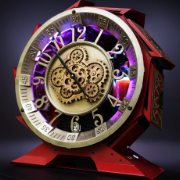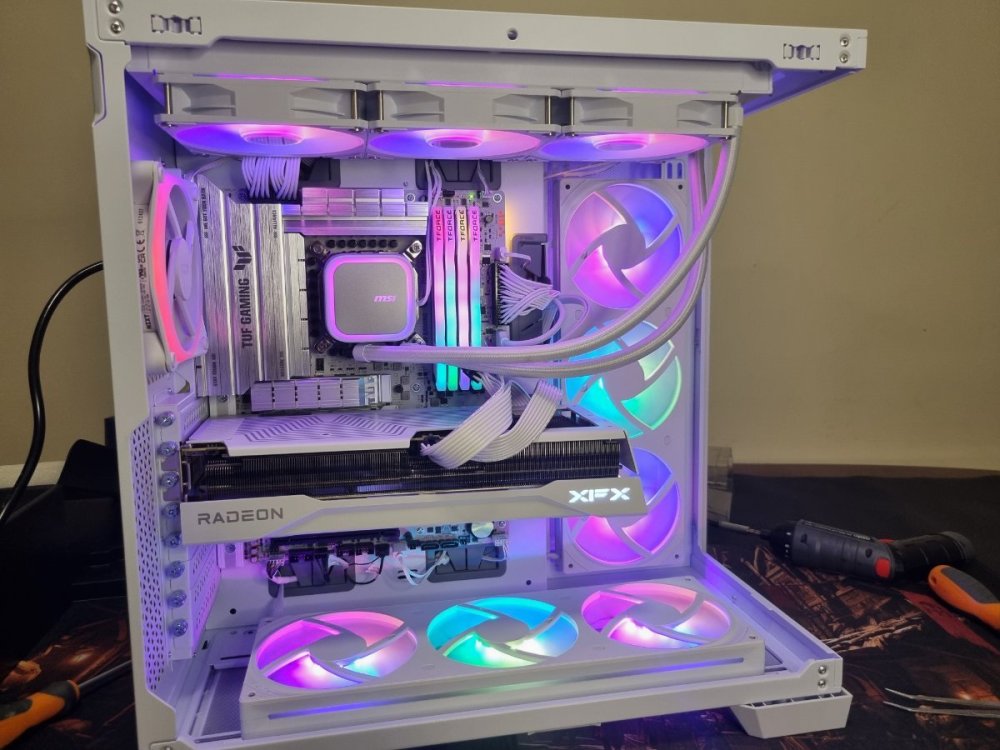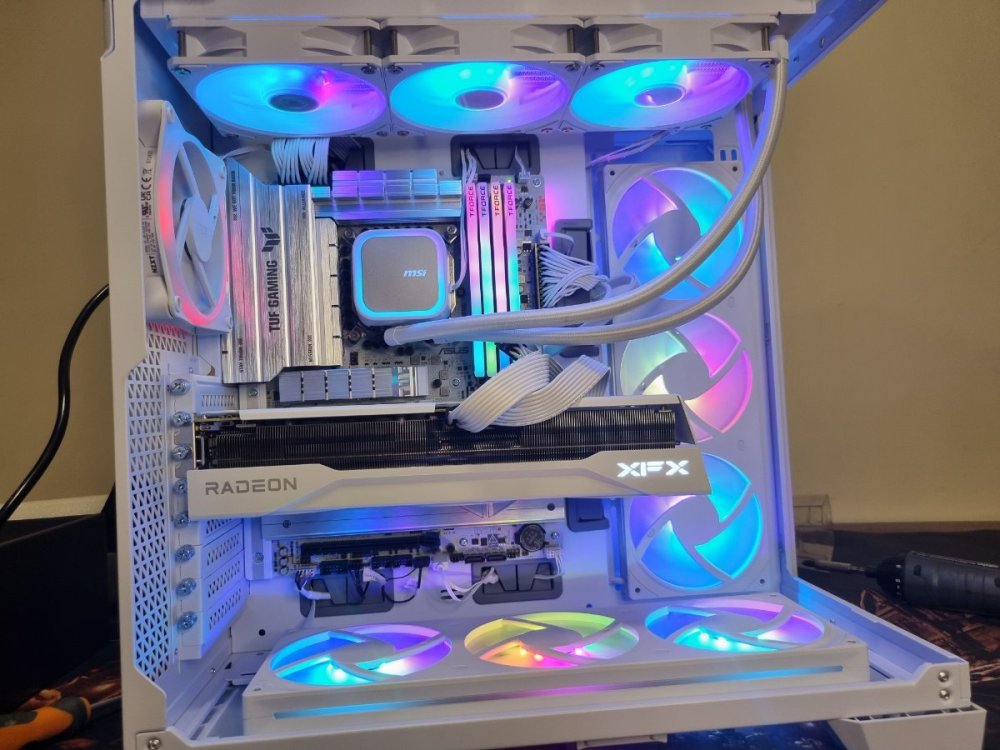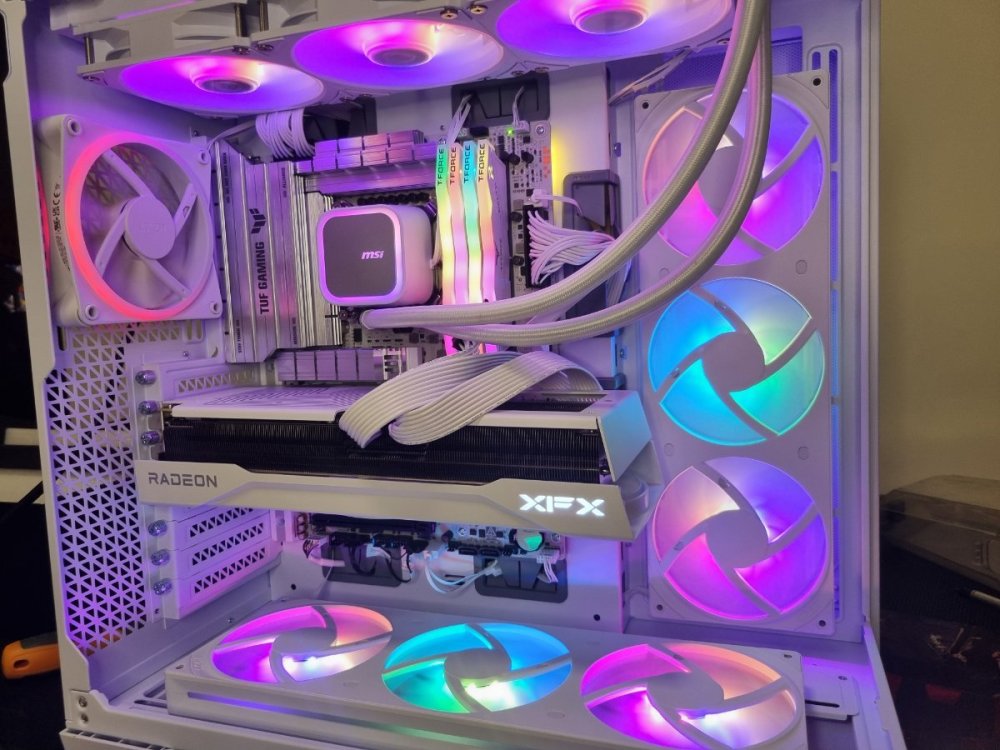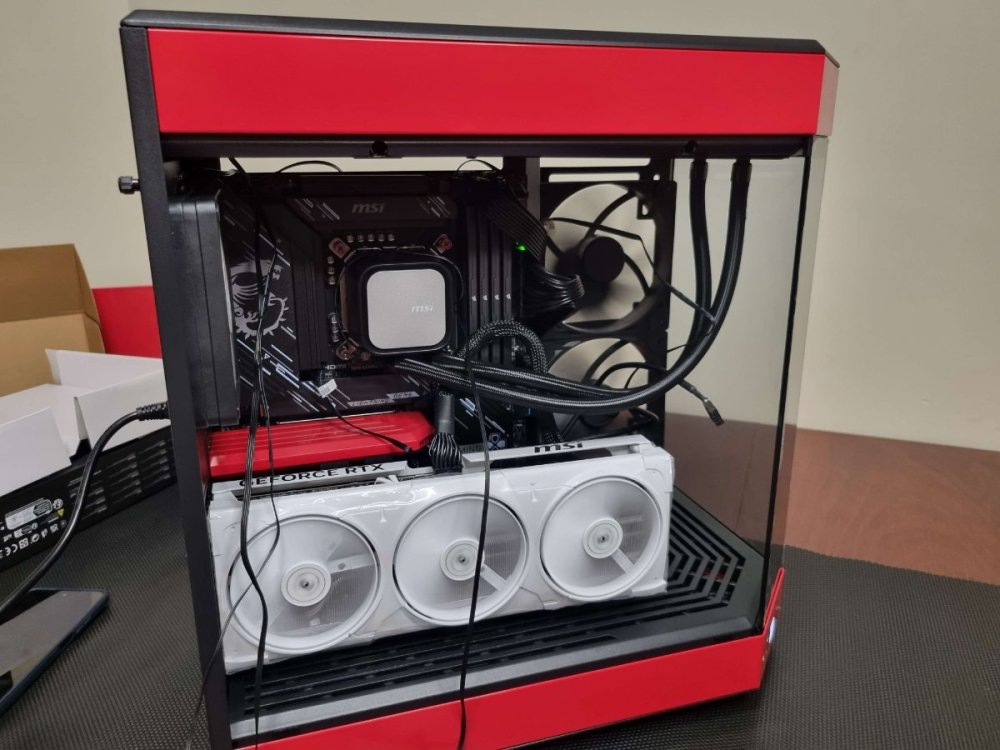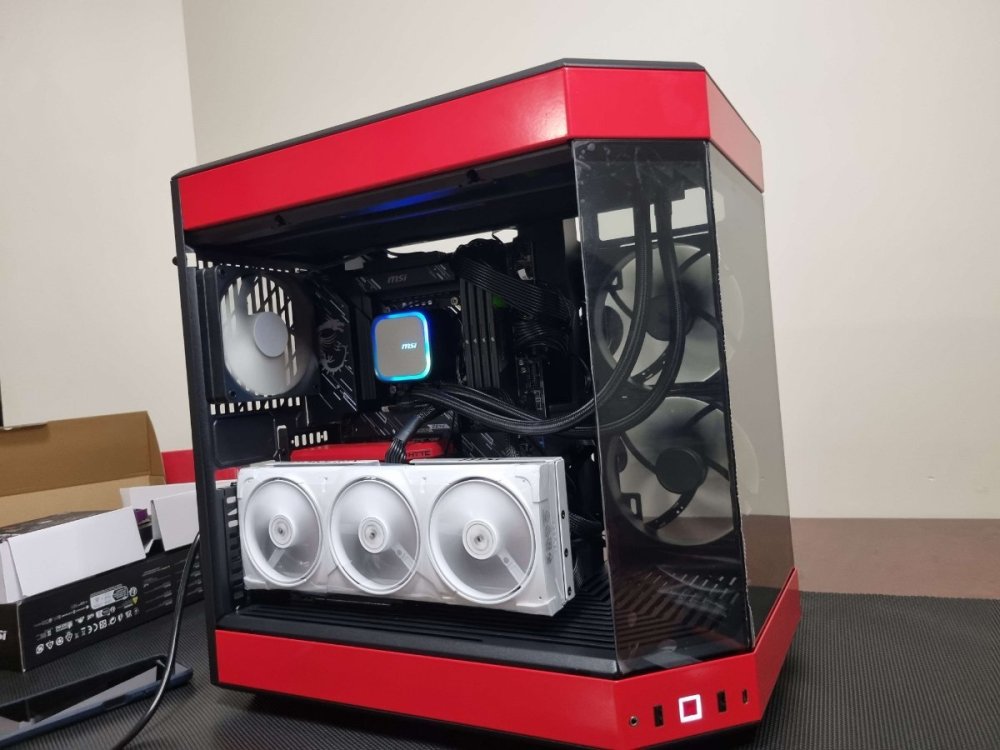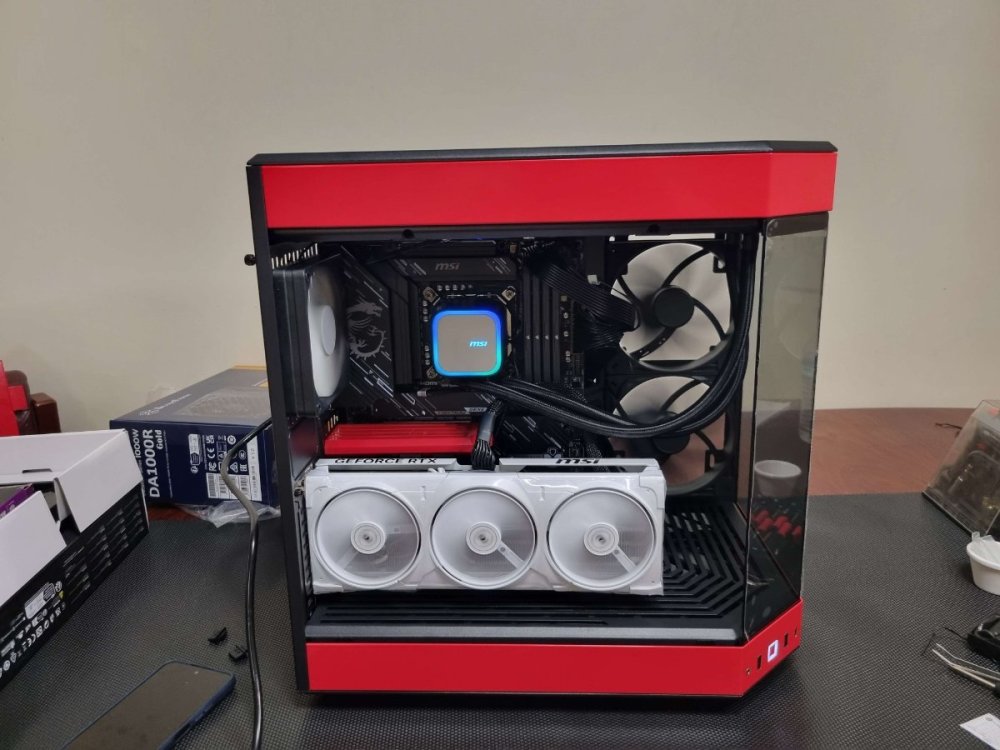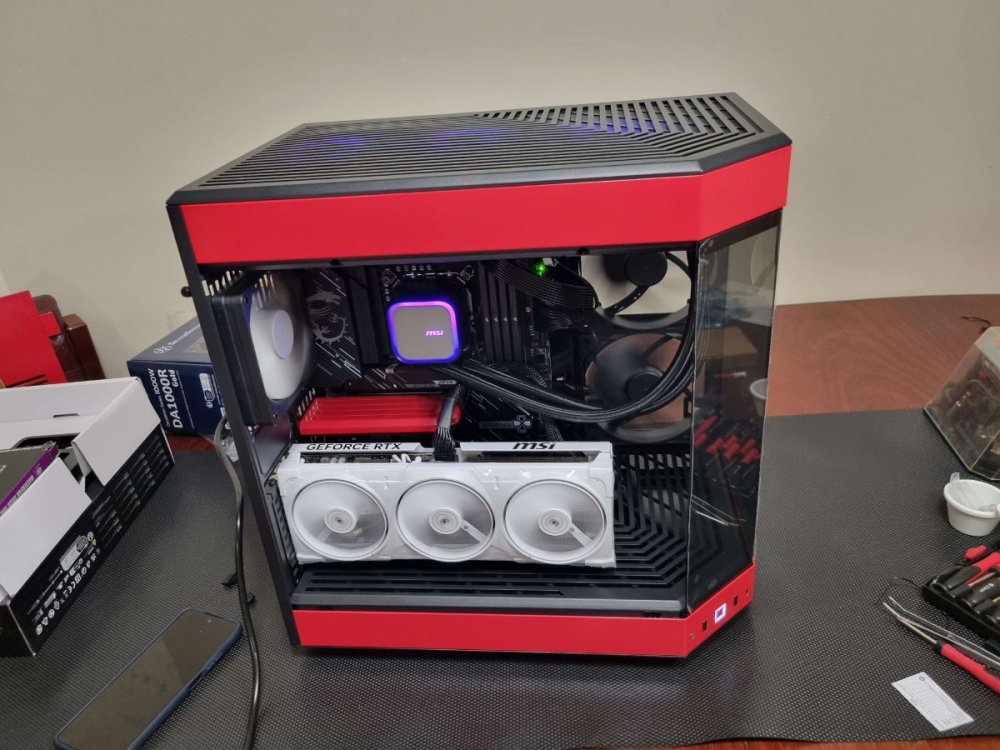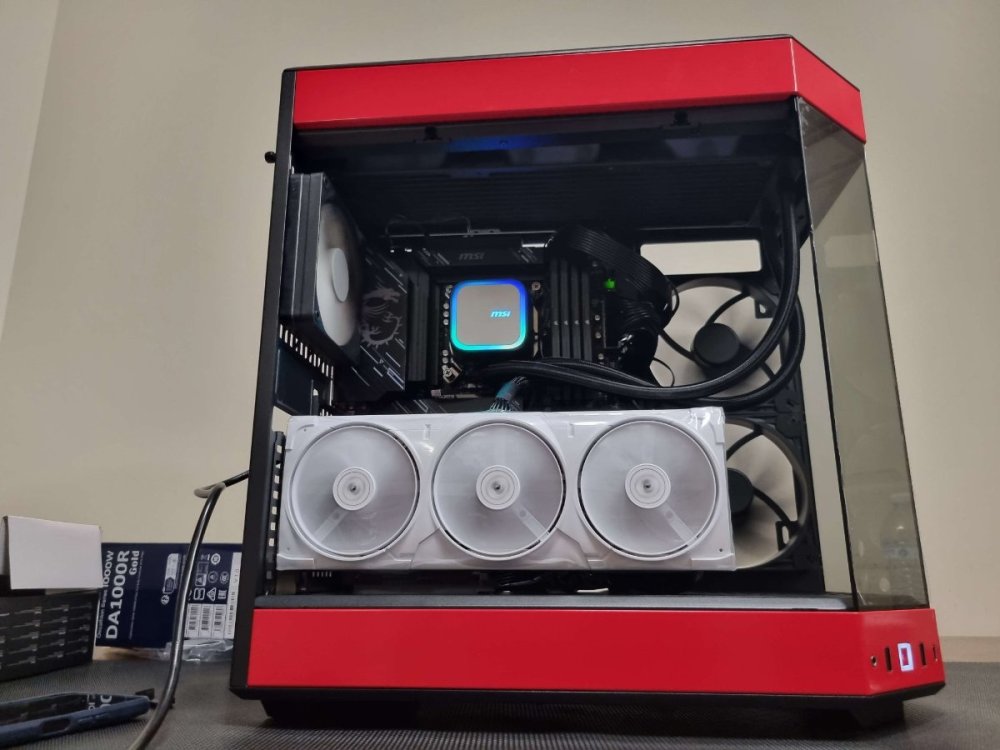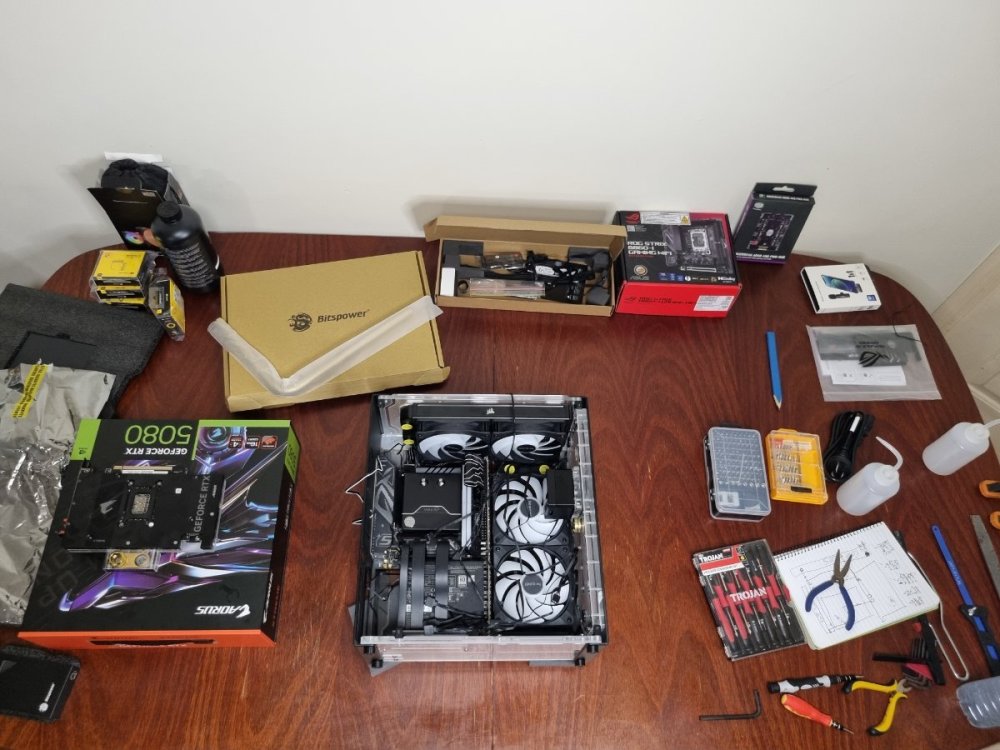Overview
About This Club
- What's new in this club
-
Tmac86 joined the club
-
Hello, I received my pc reward yesterday, and upon trying to start it up, I was stuck at the UEFI Boot shell. The BIOS detected my ssd but did not show any bootable devices. I tried various things, such as disabling secure boot and unplugging peripherals. I was eventually able to reinstall windows using a flash drive. I am now able to use my pc, but my window is unregistered. Is there any way that I could have the product key that was associated with the pc so that I don't have to buy a new license? Thank you.
-
DaWalrus joined the club
-

GPU red light/crashes
Merzal#1414 replied to Strider20A's topic in Computers's Build & Technical Help
Turns out the RAM stick was faulty, resolved with a new RAM stick ordered! -
Kingassassine140 joined the club
-
Drgnfyre joined the club
-

Hibernator WINNER 👉 Zapoo0026 - 24 Loyalty Points!
Merzal#1414 posted a blog entry in Computers's News & Updates
Congratulations Zapoo0026 on winning our BONUS reward, the Hibernator! The Hibernator was not claimed by a previous member a few months ago, after trying to contact the member several times from different emails over multiple months, we decided to reroll this one as a bonus reward on top of our new big reward and supplement reward! Watch the spin LIVE here Check out the show case for the hibernator Check out the build time lapse And the full walk through Specifications are outlined here Have fun in the next PC giveaway! We'll be doing more bonus computer giveaways every couple months, next one is in December for the Lilith PC based on our concept short. Here's a sneak peak of one of the panels we modelled and are currently building out! Video (1) (4).mp4 -
Hellscare joined the club
-
johanolsson joined the club
-
First Time Doing our BIG Reward and Tmac86 won the $10,000 CRIMSON PC! WTF?!
Tmac86 commented on Merzal#1414's blog entry in Computers's News & Updates
Unbelieveable! This is crazy because i was in and out of the stream all day while I was at work and I just missed the drawing and then didnt even know I won! -
Zco joined the club
-

First Time Doing our BIG Reward and Tmac86 won the $10,000 CRIMSON PC! WTF?!
mikahelll1 commented on Merzal#1414's blog entry in Computers's News & Updates
congratulations to the long time supporter!!!! cant wait for his ideias for customization -
Congratulations Tmac86 with 149 Loyalty Points! - Thank you for being a long term supporter. Your name came up on Raxx's stream and then the Crimson PC slice came up right after! Absolutely insane that the first time we do this we hit the 10k PC! I can't wait to hear what you want to build with it, this PC is going to be absolutely insane! If you want to split it as well we can put whatever part into the PC and the rest into anything else like cash or peripherals! Up to you man. Watch this live next time on https://twitch.tv/crimsonlootcarnival around 1 hour 47 min in, Raxx spins it and it hits your name, then he spins the https://www.thecrimsonmarket.com/pcgiveaway wheel and hits CRIMSON!!!!!!!!! Watch it here ->
-
FireLion1983 joined the club
-
snowmann420 joined the club
-
HoneyBadger#1772 joined the club
-
QQ joined the club
-
AnG|Brandon joined the club
-
t0mbzee joined the club
-
Congratulations EchoT - Winner of the Crimson Anniversary PC!
EchoT commented on Merzal#1414's blog entry in Computers's News & Updates
Mine blown! -
Levi_live_TV joined the club
-

Congratulations Connort! You won the Last Epoch PC - Zumi won the PS5 Pro
BloodRaveen commented on Merzal#1414's blog entry in Computers's News & Updates
Insane look for the illusionator! I like it 😄. -
WatcherSix joined the club
-
We finished this bad boy, we did two rounds on the panel because we were experimenting with how to get the optical illusions to look the best while also being able to see the components inside. I really love this one and think we will do more of these because we've brainstormed a few more ideas regarding how far we can go with the optical illusion blending with the inner components. This also made me think of a new stream our team might get into, which is kinetic computers, ones that move in interesting ways. Unboxing : Timelapse: Full Build: Showcase: Please let us know what you think in the comments below!
-
The Last Epoch PC Giveaway was won by Connort! 84 Loyalty points! Thanks a lot for your ongoing support! And the PS5 Pro was won by Zumi who had 14 loyalty points! - Golden Ticket is awesome?! Congratulations guys! You would have received a delivery form to fill out from socials@diablo4traders.com and a message directly from me at mr@thecrimson.company. Let's get these rewards to your door step! We have the illusionator PC up next, keep an eye out on our youtube https://www.youtube.com/@CrimsonComputerClub for more updates on it! I can't believe how trippy it turned out to be!
-
zumi joined the club
-
BigPapi763 joined the club
-
rukalion joined the club
-
yesididthatthankyou joined the club
-
TP_iMighty joined the club
-
Konstantino83 joined the club
-
Dotbombs joined the club
-
BloodRaveen joined the club
-
Rappy#11865 joined the club
-
F0xbait#1505 joined the club
-
Madseeker joined the club
-
FalseEight#1133 joined the club
-
ilyast joined the club
-
cmuservices joined the club
-

Congratulations EchoT - Winner of the Crimson Anniversary PC!
Merzal#1414 posted a blog entry in Computers's News & Updates
A member with 126 points has won the Crimson Anniversary PC! I'd like to take this time to thank all of our members for the support, we're really happy when someone with a lot of points wins! We're already working on packaging this bad boy up for EchoT! The next PC is the Last Epoch PC We've made a couple posts about it. https://www.facebook.com/share/v/16RttMPgeo/ The reddit post is getting heaps of recognition! Pop in and drop a comment, or leave one here to let us know how you feel about this one. We're doing it in just 2 weeks, so we are doing two computers this month! -
Step 1: Alright so first of all, we start by grabbing out the Motherboard, CPU, RAM, M.2 and the backplate for the CPU Cooler. Step 2: Now that we have all of that out and ready, we install the CPU first. So I had to open the CPU socket, then install said CPU making sure the triangles in the corner line up. Step 3: Now it was time for me to remove the M.2 heatsink cover from the motherboard, and install the M.2. Which with this case was completely toolless. After the M.2 was installed, I undid the 4 clips on the RAM sockets, and installed all 4 sticks of RAM into the Motherboard. Step 4: Easy step now, all I had to do was remove the sticky cover from the CPU Backplate, line it up with the screws and push down against the piece. Only slightly so that it contacts with the back of the motherboard and sticks there. Step 5: Alrighty, now it was time for me to prep and install the Power Supply. Firstly was to plug in, the 24 pin, 2 8-pin CPU power, 2 8-pin PCIE power cables, and the 1 sata power cable. Alright, next step was to turn the case around, and install the Power Supply into the back of the case. Step 6: I was now at the time to install the Motherboard into the case, so I grabbed the 9 necessary screws and did just that, lining the IO shield to the back of the case Step 7: Okaly Dokaly, the next step was to install the AIO CPU cooler. Now I'm going to start by grabbing it out, making sure the fans are in the layout I was wanting (they were). Now that I was ready, I grabbed the Radiator and fans, and installed them into the top of my case, securing it with the 12 included screws. Step 8: It was now time to apply some Thermal Paste to the CPU, and then install CPU cooler. So that's what I did, I applied some Thermal paste in my traditional "X with dot" pattern. Step 9: Now one of the most tedious parts of building a PC has arrived, cable managing. So I quickly installed my fan hub into the bottom of the back of the case, by removing one of the unused SSD bays. I then started running cables, and managing exactly where I wanted each cable to go. This was an absolutely long job, probably almost 2 hours, getting ALL the cables exactly where they would look best. Step 10: Now the time has finally arrived, to install the funnest and usually most expensive part into a PC, the Graphics Card. Now this is an easy part, but it really just ties together an entire computer. So with the Graphics Card installation, and the 2 8-pin PCIE cables plugged in, I had a completed computer. Step 11: This step was just about turning it on, and making sure it power cycles and boots, which no issues of course.
-

Crimson 2nd Year Anniversary PC "Crimson Rari"
Merzal#1414 posted a blog entry in Computers's News & Updates
Hey everyone, We finished up on this months PC for our club. We call it the "Crimson Rari". Here is the full build log : Our showcase : Build timelapse : Build walk through : Unboxing : Let us know what you think in the comments 🙂 We'll be sending it to someone in 3 weeks! -
Hi everyone, First of all, I'd like to apologise to anyone who has been caused an inconvenience due to our cancel / refund system in the last 2 months or so. Due to a change in PayPal where we had to migrate from what's called "IPN" to "Webhooks" in a rush as IPN is is being deprecated, a few bugs emerged without us knowing because there is nothing in PayPal's documentation which states IPN subscriptions are separate from Webhook subscriptions, this concept still makes no sense to me. What it means is, if someone subscribes through the IPN flow, their subscription does not trigger webhooks, this really bewildered us since the subscriptions look exactly the same in the PayPal dashboard and thus, the result caused complete havoc. Since we changed from IPN to Webhooks, we also had to restructure how our data looks, changing the concept of how we format subscriptions entirely, this meant that Stripe subscriptions were not exempt from trouble. While developing solutions and fixing everything, we tried our best to stay on top of emails and send out countless refunds and help everyone we could to manage their subscription, I personally dedicated a large portion of my day to dealing with the issues this migration caused. It is possible to manage a subscription directly in the PayPal & Stripe dashboard but we understand that it is important for this process to be made as easy and fluid as possible, we really want to make sure members are happy with what we provide. We worked tirelessly with one goal in mind, fix the cancellation process and the refund process, making it easy and hassle free for people trying to achieve these two things. After rigorous testing extending weeks, we believe that the new subscription management dashboard is ready for use, it also now comes with email notifications to our team on failed cancellations and refunds, so we can proactively look into the problems and make sure members are happy. Here's where you find it. https://www.thecrimsonmarket.com/account Click on the Manage Subscription button here. This will take you to the new dashboard. Here's what it looks like with the emails redacted. This dashboard allows you to see each individual subscription, how many points you have accumulated for it and of course, cancel it. Now we have also revamped and upgraded our refund system. Which you can find by clicking on terms & conditions in our footer. And finding the refund policy. And clicking the Refund Me button. There you can select eligible subscriptions and refund them! Remember, the most we can do is send triggers & events to PayPal and Stripe, we've tested it to our best ability so far but with third party integrations there can always be caveats, plus, software in general is complex and there can always be something missing. We will continue to monitor everything and improve this system, there is a dedicated section of the team now working on making the Cancel & Refund systems are good as they can be with one main goal of making it easy for people to cancel. If people can also provide their reasons for cancelling and refunding, that is very helpful for us to improve the world wide gaming club for everyone else. Please keep in mind we are a group of Family & Friends, while our group is growing, we are not at the scale of something like Facebook or Reddit, however, we take bugs and members very seriously and will work towards making things good and right a lot harder than an employee of a standard company as TCM is really a reflection of who we are and what we want to achieve. - However we are still human and can miss something here and there, I only ask that you let us know in a manner which helps us identify and fix the issue. If you have any issues, please do not hesitate to email us or create a ticket on discord, I will happily be at your service 🙂 If you have any feedback for our cancellation and refunds are handled, please drop a comment below! If you are here and are about to cancel or make a refund, thank you for your initial interest in TCM and our world wide gaming club, even if you signed up for free and left within your 30 day period, just know that the Golden Ticket was designed for people like you to have the opportunity to get the PC for free, so I'd like to thank you for trusting us and at least dipping your toes in 🙂 Have a good day!
-

Gangel#1581 Won The Kintsugi - Here's the Recap video!
Merzal#1414 posted a blog entry in Computers's News & Updates
Congratulations to Gangel Here is the time stamp for the video in case you missed it. -
Crimson PC Build Log Step 1: Alright guys so here we are for the Crimson PC, so first of all, we start by grabbing out the Motherboard, CPU, RAM, M.2 and the backplate for the CPU Cooler. Step 2: Once we got all that out, we start by opening the CPU socket bracket, and inserting the CPU into the slot, ensuring that the triangle on the Motherboard and CPU are aligned up, now I actually couldn't find said triangle on this particular Motherboard, I'm sure it was there I was just unable to find it, so I just to line the pins on the Motherboard to the pins on the CPU. Step 3: Next to install was the M.2, so I had to remove the M.2 heatsink/cover so that I could install it. Now with this board in particular it was completely tool less, I undid the button slip on the left side of the cover and it popped straight up, now I instert the M.2 into the slot and turn the pre installed tool less clip that holds it down. Once completed I removed the plastic off the thermal pad on the inside of the cover and reinstalled it. Step 4: Now I was ready to get my RAM installed with was easy enough, the board has 4 slots and I was using 4 sticks, so no need to check the manual to find which slots were for dual channel. I then undid the clips on the end of each of the 4 Ram sockets on the motherboard and installed them 1 by 1, ensuring along the way that my sticks were aligned to the orientation of the socket. Step 5: This step was quick and easy, I grabbed the backplate for the CPU cooler, and removed the plastic from the double sided tape it uses to stick to the motherboard. I flipped the Motherboard over, and installed it onto the back of the CPU socket. Step 6: I then grabbed out my Power Supply and the necessary cables for this computer, now I didn't realize this at this point but I will point it out, the Motherboard we used actually needed 2 8-pin EPS power cables for CPU power and a dedicated 8-pin PCIE power cable for PCIE power. So I used those cables, a 24-pin, a 600w Graphics and a Sata power cable. Once I had them all installed, I was able to install the Power Supply into the back of the case. Step 7: I was now at the time to install the Motherboard into the case, so I grabbed the 9 necessary screws and did just that, lining the IO shield to the back of the case. Step 8: Now it was time to grab my AIO CPU cooler and get it ready for installation. So to start doing this, I removed the Radiator mount from the top of the case, by undoing the 6 screws on top and pulling it out. Once I had that removed, I was ready to install my Radiator and fans to the mount. Now here's where things get interesting, I tried to mount the Radiator on top of the mount with the fans on the bottom, but this was impossible. The provided space for the tubes coming out the Radiator to go, were not big enough to fit this Radiator. So after installing it all once that way, I had to remove it and place the fans on top of the mount and the Radiator on the bottom. Step 9: So this is where I was ready to install the Graphics Card, or at least I thought I was ready. I installed the Graphics Card to find out, that all the Motherboard cables like the fan headers and the ARGB headers were all behind where the Graphics Card was to sit. So I then had to remove the Graphics Card and start plugging in the cables. Step 10: At this point I have realized that the Motherboard had only 6 fan headers and I was going to need 7. So I went and grabbed a PWM fan hub and installed this into the back of the case. I actually installed it into the hard drive bay (due to only using m.2 on this build that space was completely unoccupied) Step 11: Now that I have rectified the issue of not enough fan headers, I went back to plugging in all my cabling and sorting out the best runs for them to look neat in the computer. Finally after doing all this, I was finally ready to reinstall the Graphics Card. Step 12: Now that the Graphics Card is back, I have finally got completely build computer and am ready to plug in and turn on. Here we go, I plugged her in and unfortunately one of the fans were not spinning, so I had to turn it back off and reseat (just basically unplug it and plug it back in) and turn it back. This time the fan was spinning and the computer was fully working Step 13: So now all that was left was to plug it in and install windows. I also played with a couple of the settings in the bios to get the best performance from this computer.
-

Kintsugi PC Giveaway happening in the next few hours!
Merzal#1414 posted a blog entry in Computers's News & Updates
This is a really nice PC, I almost don't want to send it away xD It's simple and elegant, it's got that see through, gold, theme and I love it. It is themed to Elden Ring originally, we've got the Elden Ring symbol etched onto the glass which is pretty awesome! Here's all the content. Kintsugi Build Time Lapse Kintsugi Elden Ring PC Show case Kintsugi PC Unboxing And we have 6 episodes of the walk through to build it. Here is Part 1 Also you can check out the full written build log in the build log section of this club. So it's in just a few hours on Raxx's stream, I wish you the best, we'll be revealing the "Crimson Computer" in the next few hours as well! -
Renzo joined the club
-
IggyDesaad joined the club
-
jdebiase joined the club
-
Chaseur joined the club
-
Kintsugi Build Log Step 1: Alright so I started by grabbing the motherboard out and placing it on it's box Step 2: I then opened the CPU socket on the motherboard and whilst making sure the arrows in the corner lined up, installed the CPU into it's socket. Then I closed the socket with the lever, popping off the cover in the process Step 3: Next step I did was grab my CPU water block mounts and installed them into the motherboard, after that I then applied the thermal paste to the CPU and screwed on the water block. Step 4: I grabbed my 4 sticks of ram and installed them in the ram slots. Step 5: Then I grabbed out my case, laid it down and removed the side panel. (The next step was done out of instinct as it's the way I have usually build PC's, however I would 100% recommend you do this step after you have installed the Power Supply into the included Powerboard and then into the case) Step 6: I then installed the motherboard into the case, using the cases included mounting screws. Step 7: I then had to install the Powerboard onto the Power Supply, however this was easier said than done, let me explain. The sheer amount of force that it took to install was unbelievable. I had to use all my might to make sure every connector was 100 percent inserted. I thought it was quick and easy to install, but after close examination I found that the connectors werent going in without me forcing them. Step 8: Once I had it completely inserted I had to get the Power Supply and Powerboard installed into the case. On the backside of the case there was a small hook shaped bracket that needed to be removed as well as a Power Supply cover bracket. Got both of them out, and now had to get the Power Supply in. At this moment I realized this case actually had another bracket on the bottom of the inside of the case, this bracket was to be preinstalled onto the Power Supply prior to its installation in the case. I unscrewed the 2 screws holding this bracket into the case and installed the bracket onto the Power Supply. Step 9: Now that I have rectified the bracket issue, I can finally install the Power Supply into the case, and this is where my issue I mentioned earlier arose. Installing the Power Supply with the Motherboard already installed was almost impossible, I had to kind of angle it into place, where the Powerboard would slot into the mentioned hook shaped bracket. Once I had that lined up, I was able to screw the bracket I had previously installed onto the Power Supply to the bottom of the case. Step 10: At this point I was ready to start working on the Radiators, both of which were 240mm and required 2 fans installed onto each prior to their installation into the case, so that's what I did, I then went to install the radiators into the case and quickly found out that the screws that came with the radiator (which are long enough to go through a standard metal frame case which is usually only about 2 or 3mms thick) were not long enough to go through the thicker acrylic on this case. So I had to go and get some M4x10mm bolts (12 of them). Once I had the necessary bolts, I then installed the radiators to the case. Step 11: Alright so at this point, it was starting to look like a computer but with a very messy birds nest of cables everything, so I took a little bit of time moving the cables around and connecting the 2 fans of each radiator together, daisy chain style and plugged them into the Powerboard. I also grabbed the included 24 pin and 8 pin ribbon cables that came with the case, and got them installed into the Powerboard and Motherboard. Step 12: Now this is where another issue arose for me, I was so quick to get things installed into the case, I forgot that this case comes with a touch screen button and that the cable wasn't installed into the case yet, I so had to grab that cable out of the box, and my long reach tweezers and plug it into the bottom of the Powerboard and into the bottom of the front panel of the case. Step 13: Now it was time to get the Graphics Card installed, so this case specifically came with a riser cable, so I installed it into the Motherboard and then installed the Graphics Card into the vertical mounted riser PCIE slot. Step 14: At this point I was ready to get all my fittings installed onto the Graphics Card, CPU block, both Radiators and the reservoir. Now the Graphics Card came with the plugs on the back and the space for the fittings at the front, so firstly this was where I had to waste some time and get the Graphics Card out of the case again, and move the plugs from the back to the front. Now I was able to install the Graphics Card fittings into the back of the Graphics Card. Step 15: Now I can actually get my fittings in without issue, firstly I installed a 90 degree g1/4 brass fitting into the inlet and outlet of the Graphics Card, with one facing upwards but on a slight angle towards the CPU block and the other going straight towards the bottom of the reservoir panel on the front of the case. Once they were on, I then installed a g1/4 to 14mm OD brass fittings onto both. Step 16: Next step was to add my 2 fittings into the CPU block, now 1 of which, the right side, was a 25mm extension fitting and a 90 degree fitting facing down towards the Graphics Card fitting I had previously fitted, after that I then installed a g1/4 to 14mm OD fitting. The left side of the CPU block though was a straight fitting, ready for a clear tube to install. Now this was a big issue that arose once the building process had already been started. The bend necessary to get from the CPU block to the top Radiator was impossible with brass pipes. Brass pipes can only make a 90 degree bend with enough length as to not crease or crack. Now I'm going to mention now, that I did also have this issue with another part of the water loop. When going from the back Radiator to the top of the Reservoir panel at the front of the case, so I had to install a clear tubing here as well. Step 17: Alright, so it was time to get the fittings into the Radiators, so as just mentioned the back Radiator, had 1 straight fitting for clear tubing. However the other side (left) of the Radiator needed not 1 but 2, 25mm extension fittings, a 90 degree g1/4 fitting and then a g1/4 to 14mm OD brass fitting, and all of that was necessary so that I would be able to get the brass pipe around the Powerboard. Step 18: Now we were able to install the fittings onto the top Radiator. Which the back one was the other end of the clear tubing, so all that was installed was a g1/4 straight fitting. As for the front fitting, I had to install a 25mm g1/4 extension fitting, a g1/4 90 degree and a g1/4 to 14mm OD brass fittings. Step 19: At this stage we had got all the fittings installed minus the inlet and outlet of the reservoir front panel. So we next did that, installed a g1/4 clear tube fitting onto the top and installed a g1/4 to 14mm OD brass fitting into the bottom. Step 20: Time has now arrived for me to start measuring and cutting the tubing. So, I started with the clear tubing as it would be the easier of the 2. I cut the tubing into 2 lengths to fit the 2 spots I would be using the clear tubing. I then got them installed into the case, ensuring that both the O-rings for the fittings were all in place and that the fittings were secured as tight as possible. (TIP: ENSURE THE FITTINGS ARE TIGHT AS CAN BE) Step 21: I, now grabbed out my brass tubing and measure the 3 pieces I was going to need. Once they were cut I lightly filed back any and all burr's that arose from cutting the brass tubing. I was now ready to install the last of the tubing, I started with the top tube going from the top Radiator to the back Radiator, again ensuring every single connection was tight and every O-ring was where it was intended. I then installed the brass pipe from the CPU to the GPU, and then the Graphics Card to the bottom of the reservoir. Step 22: Now with all of that done, it was time to install the DDC pump to front of the case in the intended space provided. All that was left was to install the molex power to the Power Supply and the pump header into the Powerboard. Step 23: Now it's finally arrived, it's time to fill the loop. Thankfully this is done very easy on this build, thanks to a switch at the top of the Powerboard. Now this switch works like a manual power jump start for the DDC pump. So instead of having to unplug everything from the Powerboard except the DDC pump, we are able to just use this switch to fill the loop. So firstly, I filled the reservoir built into the front panel, by removing the plug at the front, and filling the loop with our coolant solution. Once the reservoir is full, I then use the switch on the Powerboard to boot up the DDC pump and start pumping the liquid, once the reservoir is at about 30 percent full, I would flip the switch off and fill it back up. Then repeating this process til the loop is full (DON'T LET THE RESERVOIR COMPLETELY EMPTY OR YOU WILL GET AIR BUBBLES IN YOUR LOOP) Step 24: Okay so at this point we are done with the build, so it was time to boot up the PC at my workbench, test that it boots, go into the bios, tweak the few setting necessary to get the best performance out of the computer, like enabling XMP to get the max ram speeds from the DDR5 sticks we used. Step 25: Now all that was left was to install Windows 11, and we're done.
-
antrez93 joined the club
-
reeferreesor joined the club
-
Se12iouS joined the club
-
Elfiebb joined the club
-
We will spin for the Xbox Series X
-
We will reveal our next reward, the Elden Ring Kintsugi.
-
untilWe'll be spinning for the 24ct Gold PC!
-

How to cancel Crimson Market monthy subscription? Overhaul
Merzal#1414 posted a blog entry in Computers's News & Updates
Hi everyone, We are working on overhauling how cancellation works at TCM. Currently to cancel your membership at TCM you go through these steps. Login Click on your name in the top right corner Click on Account Settings Click on Manage subscription Add a Reason (helps us make the club better for people) Click on Cancel (NOT STAY) --------------------------------------------------------------------------------------------------------------- For anyone who has been burdened by the current process, please keep in mind that we did this as quickly as possible after we realised the PayPal dashboard was being a pain for people to cancel their subscription, especially in some countries where the PayPal dashboard is different to what we see in Australia where we figured it would be easy to manage. Our current system also cancels every single subscription you have with us in one go, I know some people don't want this as I've been messaged several times about people wanting to cancel just one of them but this should also show to people that we are not here trying to invent things to make it difficult for people to cancel the club, in fact we are trying to do the exact opposite we just do not have infinite time and resources to achieve what we want instantly. ----------------------------------------------------------------------------------------------------------------- We want to make the cancellation process smoother for everyone, we are working on a dashboard dedicated for managing subscriptions individually so people can see exactly what's going on. TCM wants members to not be frustrated by cancelling and we want to at least know why someone is cancelling so we can work on improving the club for our members. If you have any feedback or feature requests in terms of managing a subscription which can involve cancelling or even resubscribing later, please add a comment below. -

Membership overhaul for Supporter system causing Issues & Bugs
Merzal#1414 commented on Merzal#1414's blog entry in Computers's News & Updates
We just finished fixing everything, sorry for the inconvenience, we are working really hard to evolve memberships into something more valuable to everyone involved, with the ground work that's been laid out during this month, we will be able to move forward in terms of making it a lot easier to see your individual subscriptions and manage them one by one. Our priority is to make sure people can join & cancel as smoothly as possible and have all of the information regarding their membership available to them. Thanks for being patient and please do not hesitate to reach out if you have any issues with your account, preferably on discord or on here as emails can easily get lost in the sea. -
borko63 joined the club
-

Membership overhaul for Supporter system causing Issues & Bugs
Merzal#1414 posted a blog entry in Computers's News & Updates
We are aware of some issues being caused by the recent overhaul to how memberships and subscriptions work for the club. Please do not worry as everything is tracked in PayPal & Stripe, if you are seeing "Not subscribed" Or have not received loyalty points for a recent payment, this is mostly a User Interface bug. We will make 100% sure everything is resolved by the next spin, we are trying our best to fix everything up, ultimately we take anything related to loyalty points very seriously and have vigorous logs, event tracking and more on our side as well as on Stripe & PayPal's side. It's very important to us that everyone has the exact LP they should have and are active when they should be so we will triple check everything and once the news comes out that everything is fixed, if there is anything off with your account please do not hesitate to notify us (A news post will be made once the issues are considered to be resolved) I think it goes without saying that what we are trying to accomplish here is pretty complicated and bound to have some technical issues but we have always been able to track down any issue members have had, we are here to serve you noble Gamers. Please bare with us a bit 🙂 - On a side note, we are also working on a way to show all of your separate subscriptions in a new dashboard page in account settings so you can manage each of them more dynamically as well as get more information about what you have and how. So there's that 🙂




